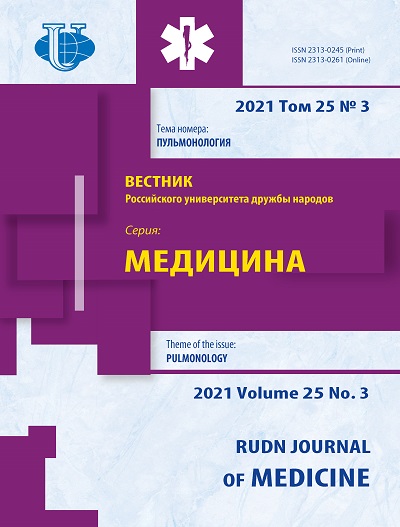Jadassohn anetoderma: clinical observation
- Authors: Mesnyankina O.A.1,2, Ryabov S.K.1,2
-
Affiliations:
- Astrakhan State Medical University
- L.L.C. Consilium
- Issue: Vol 25, No 3 (2021): PULMONOLOGY
- Pages: 243-247
- Section: DERMATOLOGY
- URL: https://journals.rudn.ru/medicine/article/view/27541
- DOI: https://doi.org/10.22363/2313-0245-2021-25-3-243-247
Cite item
Full Text
Abstract
The article presents a clinical observation of a rare dermatosis - Jadassohn anetoderma. The described case demonstrates the important role of differential diagnostic in patients with atrophic skin changes, paying attention to the possibility of rare dermatoses. Difficulties in diagnosing such diseases are largely due not only to the low frequency of occurrence in the practice of a dermatologist, but also to the sometimes-untimely treatment of patients due to the lack of subjective sensations, especially when the rashes are located in places inaccessible for self-examination. At the same time, despite the fact that the exact pathophysiological mechanisms of the development of anetoderma remain unknown, a number of studies indicate the possibility of autoimmune diseases of the connective tissue, antiphospholipid syndrome and an increased risk of thromboembolic complications in such patients. This fact convincingly proves that the timely diagnosis of anetoderma not only makes it possible to form the correct approach to the management of such patients, but also to provide vigilance regarding the development of autoimmune pathology of the connective tissue.
About the authors
O. A. Mesnyankina
Astrakhan State Medical University; L.L.C. Consilium
Author for correspondence.
Email: olga_mesnyankina@mail.ru
ORCID iD: 0000-0003-1599-301X
Astrakhan, Russian Federation
S. K. Ryabov
Astrakhan State Medical University; L.L.C. Consilium
Email: olga_mesnyankina@mail.ru
ORCID iD: 0000-0003-1599-301X
Astrakhan, Russian Federation
References
- Thomas JE, Mehregan DR, Holland J, Mehregan DA. Familial anetoderma. Int. J. Dermatol. 2003;42 (1): 75—77.
- Kineston DP, Xia Y, Turiansky GW. Anetoderma: a case report and review of the literature. Cutis. 2008;81(6):501—506.
- Pal’cev MA, Potekaev NN, Kazanceva IA, Kryazheva SS. Clinical and morphological diagnostics and principles of treatment of skin diseases. A guide for doctors. M.: Medicine. 2006;205—206. (In Russ)
- Ufimtseva MA, Gerasimova NM, Bochkarev YuM, Surganova VI, Ioshchenko SE. Anetoderma in a patient with syphilis and tuberculosis. Dermatology and Venereology Bulletin. 2006;2:56—58. (In Russ)
- Tousignant J., Crickx В., Grossin M., Besseige H., Lepine F., Belaich S. Post-varicella anetoderma: 3 cases. Ann. Dermatol. Venereol. 1990;117(5): 355—357.
- Yu H.J., Shin H., Kang M.S., Kim J.S. A case of primary anetoderma in an infant. Br.J. Dermatol. 2007. 157 (6):1267—1269.
- Pil’guj E’.I., Aslamazyan L.K., Gevorkyan A.K., Rovenskaya Yu.V. Sluchaj anetodermii u nedonoshennogo rebenka. Pediatricheskaya farmakologiya. 2013;10 (4):122—123. (In Russ)
- Maffeis L., Pugni L., Pietrasanta C., Ronchi A., Fumagalli M., Gelmetti C., Mosca F. Iatrogenic anetoderma of prematurity: a case report and review of the literature Case. Rep Dermatol Med. 2014:781493. doi: 10.1155/2014/781493.
- Kubanova AA, Akimov VG. Differential diagnosis and treatment of skin diseases: atlas-reference. M.: MIA, 2009; 242—244. (In Russ)
- Wolf K., Goldsmith L.A., Katz S.I., Gilcrest B.A., Paller E.S., Leffel D.J. Fitzpatrick’s Dermatology in Clinical Practice. Transl. from English. Moscow: Ed. Panfilova; BINOM, 2012;1:610—611. (In Russ)
- Czvetkova GM, Mordovcev VK. Pathomorphological diagnostics of skin diseases. M.: Medicina, 1986. (In Russ)
- Kondratyeva Y.S., Eroshenko N.V., Granina I.A. Anetoderma in the practice of a dermatologist. Russian Journal of Skin and Venereal Diseases. 2015;18(1):21—24. (In Russ)
- Molochkov VA, Karzanov OV, Prokofiev AA, Molochkova Yu V. To the effectiveness of photopheresis in anetoderma. Russian Journal of Skin and Venereal Diseases. 2013;5:22—24. (In Russ)
- Wollina U, Mühle D, Lotti T, Vojvodic A. Anetoderma Schweninger-Buzzi: Two Case Reports Open Access Maced. J Med Sci. 2019;7(18):3093—3095. doi: 10.3889/oamjms.2019.560
- Xia FD, Hoang MP, Smith GP. Anetoderma before development of antiphospholipid antibodies: delayed development and monitoring of antiphospholipid antibodies in an SLE patient presenting with anetoderma. Dermatol Online J. 2017;23(3):13030.
- Eungdamrong J, Fischer M, Patel R, Meehan S. Sanchez M. Anetoderma secondary to antiphospholipid antibodies. Dermatol Online J. 2012;18(12):26.
















